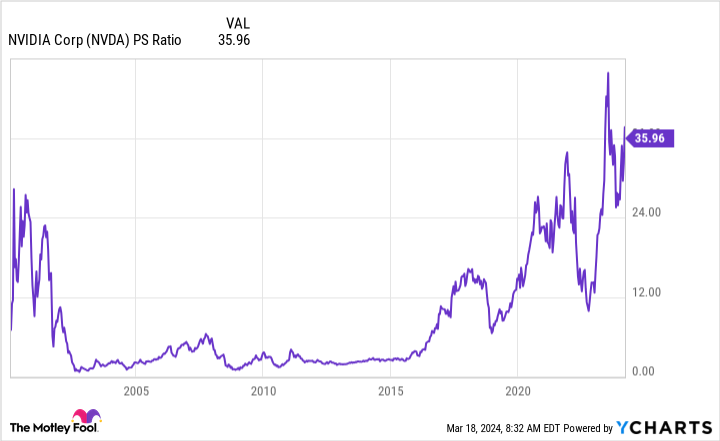There’s a shortage of high-powered chips capable of training and running advanced artificial intelligence (AI) models. Mega-tech companies are battling each other for AI supremacy, scooping up boatloads of Nvidia‘s (NASDAQ: NVDA) data center GPUs along the way, and AI start-ups with rocketing valuations are multiplying.
There’s little question that AI is a revolutionary technology. There’s also little question, at least in my mind, that AI is fueling a classic bubble. Start-ups founded less than a year ago, like Mistral AI, are already worth billions. Some publicly traded companies, notably server maker Super Micro Computer, have seen their valuations skyrocket to levels that seem illogical. Caution is increasingly being thrown to the wind.
Nvidia’s GPUs are driving the AI revolution
Nvidia and its GPUs are at the center of it all. Not only are the company’s GPUs well suited for the calculations necessary for training and running AI models, but its proprietary CUDA platform has become the de facto standard for accelerated computing over the past 16 years. With companies scrambling to win the AI race, Nvidia’s GPUs are the path of least resistance.
It’s not surprising then that demand for Nvidia’s AI accelerators has exploded. The company’s data center segment generated $18.4 billion of revenue in its latest quarter, a fivefold increase from the prior-year period. Profits are soaring as well. In the recently completed fiscal 2024, Nvidia earned a net income of $32.3 billion of $60.9 billion of revenue.
Nvidia stock has more than tripled over the past year, pushing up the company’s market capitalization beyond $2 trillion.
Shortages don’t last forever
“I’ve seen gluts not followed by shortages, but I’ve never seen a shortage not followed by a glut,” says Nassim Nicholas Taleb, who is regarded as an expert on risk. The inertia behind Nvidia’s CUDA has slowed down competitors, but a tsunami of competing AI accelerators is building. Nvidia’s incredible profits and pricing power won’t survive once supply catches up with demand.
Advanced Micro Devices launched new AI-centric data center GPUs late last year. Intel will launch the third generation of its capable Gaudi line of AI accelerators this year. OpenAI’s Sam Altman is reportedly seeking vast funding for new semiconductor factories to build AI chips. Cloud giants including Amazon, Alphabet, and Microsoft are designing and installing their own AI chips. The list goes on.
Here’s how the current shortage turns into a glut. First, insatiable demand and extravagant long-term projections drive a wave of competition. This is what’s happening now. AMD has predicted that the AI chip market will reach $400 billion by 2027. For perspective, global semiconductor sales were just over $500 billion last year.
Second, future demand inevitably falls short of these wild projections. AI chip demand can still soar in the coming years and miss expectations, given how optimistic industry players have become. Eventually, this leads to a situation where there’s more than enough supply of AI chips.
At this point, Nvidia’s pricing power would have eroded considerably. CUDA would no longer be dominant as alternatives pop up and gain traction. For big cloud companies, there’s a strong incentive to be able to support AI accelerators from a wide variety of suppliers.
Look to the dot-com bubble
This isn’t the first time Nvidia’s stock has soared thanks to a revolutionary technology. The dot-com bubble of the late 1990s and early 2000s pushed up the company’s valuation to extreme levels as well. The aftermath was a disaster for shareholders.

Relative to sales, Nvidia stock is far more expensive today than at any point during the dot-com bubble. “This time is different,” you might say. Demand for AI is real, and the company’s revenue is soaring. But you’ve just uttered the four most dangerous words in investing.
This time might be different. Or the market dynamics that play out during nearly every shortage of anything will play out once again and grind down Nvidia’s pricing power and profits. By investing in Nvidia, you’ll likely be paying a high price to relearn the lessons of the dot-com bubble.
Should you invest $1,000 in Nvidia right now?
Before you buy stock in Nvidia, consider this:
The Motley Fool Stock Advisor analyst team just identified what they believe are the 10 best stocks for investors to buy now… and Nvidia wasn’t one of them. The 10 stocks that made the cut could produce monster returns in the coming years.
Stock Advisor provides investors with an easy-to-follow blueprint for success, including guidance on building a portfolio, regular updates from analysts, and two new stock picks each month. The Stock Advisor service has more than tripled the return of S&P 500 since 2002*.
See the 10 stocks
*Stock Advisor returns as of March 18, 2024
John Mackey, former CEO of Whole Foods Market, an Amazon subsidiary, is a member of The Motley Fool’s board of directors. Suzanne Frey, an executive at Alphabet, is a member of The Motley Fool’s board of directors. Timothy Green has positions in Intel. The Motley Fool has positions in and recommends Advanced Micro Devices, Alphabet, Amazon, Microsoft, and Nvidia. The Motley Fool recommends Intel and recommends the following options: long January 2023 $57.50 calls on Intel, long January 2025 $45 calls on Intel, long January 2026 $395 calls on Microsoft, short January 2026 $405 calls on Microsoft, and short May 2024 $47 calls on Intel. The Motley Fool has a disclosure policy.
History Says You’ll Regret Buying Nvidia Stock was originally published by The Motley Fool
Read the full article here


